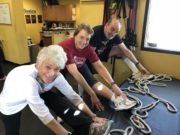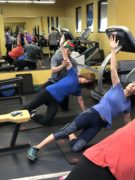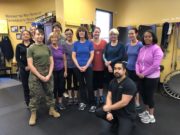2 Thumbs Up for Toys for Tots Success!



Thank you to ALL of you who contributed all sorts of fun toys in support of the Toys for Tots drive. With all of you participating, we were able to fill two boxes and then some! Thank you also to those of you who joined our team Saturday, December 1st for our special Toys for Tots workout! We all had a blast working you out and hope you enjoyed yourselves as well.
Article – Happy Un-Birthday! Why You Want to Celebrate Your Biological Age Perhaps More Than Your Chronological Age
We’ve all experienced death and dying in our lives. Whether family, friends or acquaintances not a year goes by without someone in our lives passing away. According to the National Center for Health Statistics the average lifespan of someone in the United States presently is 78.6 years. As I’m heading toward 45, that’s not so far away anymore!
Death is inevitable for all of us. How we die and when we die continues to be a topic of great interest though! Research on aging is at all-time highs as all markets seek to connect with the rising Boomer generation, those people who were born between 1944 and 1964 and are now 54-74 years of age. A recent online article written by Samantha Bresnehan for CNN spoke to this.
In it she shares her interview with Morgan Levine, a researcher and professor for Yale Medical School. Professor Levine and her colleagues have been studying different types of aging measures. Most recently her and her team discovered a relationship between 9 biomarkers found in blood that anyone can get from a standard doctor’s visit and their relationship to biological aging. They determined, based on plugging the biomarkers into different algorithms entered into a computer that individuals with a lower biological age than their chronological age have a lower mortality risk than those whose biological age is higher than their chronological age. “People of the same chronological age aren’t all at the same risk for developing cardiovascular disease or cancer or even dying,” Levine said. “What [the biological age] does is actually give us a better idea of where someone stands for their age.”
So what are these biomarkers? After reading the article and doing a search to find this information, I came upon the original submission by Dr. Morgan Levine and her co-contributors. Within it I found out the biomarkers are albumin, creatinine, glucose, C-reactive protein, lymphocyte percent, mean cell volume, red blood cell distribution width, alkaline phosphatase, and white blood cell count. Let’s learn a little bit more about each of them so that they are more front of mind the next time you go to your doctor.
1.Albumin is a simple form of protein that is soluble in water and can thicken in consistency by heat, such as that found in egg white, milk, and (in particular) blood serum. Abnormal levels can be an indication of malnutrition, liver disease, kidney disease or some kind of inflammatory disease.
2. Creatinine is a waste product that comes from the normal wear and tear on muscles of the body. Everyone has creatinine in their bloodstream. Unhealthy levels can be the result of impaired kidney function or kidney disease. As the kidneys become impaired for any reason, the creatinine level in the blood will rise due to poor clearance of creatinine by the kidneys. Abnormally high levels of creatinine thus warn of possible malfunction or failure of the kidneys.
3.You may know glucose by another name: blood sugar. Along with fat, glucose is one of the body’s preferred sources of fuel in the form of carbohydrates. You need food with carbohydrates in it like vegetables, fruits and grains to create the energy that helps keep you alive. If we have too much glucose though, we can develop pre-diabetes and eventually become diabetic.
4.A biomarker for inflammation that can be determined through a simple blood test is C-reactive protein. This biomarker has been researched more than any other for its ability to predict disease risk associated with coronary artery disease.
5.Another biomarker to be aware of has to do with what are called lymphocytes. Lymphocytes are white blood cells that are also one of the body’s main types of immune cells. They are made in the bone marrow and found in the blood and lymph tissue. Anytime we have an acute infection or illness our body will produce more lymphocytes boost our immune function so that we can heal. However when we have some kind of chronic infection of or other prolonged condition our lymphocyte percent can become abnormal.
6.Mean cell volume, also called mean corpuscular volume, is a measure of the average volume of red blood cells. Red blood cells move oxygen from your lungs to every cell in your body. Your cells need oxygen to grow, reproduce, and stay healthy. If your red blood cells are too small or too large, it could be a sign of a blood disorder such as anemia, a vitamin deficiency, or other medical condition.
7.The biomarker of red blood cell distribution width (RDW) is another means of determining our health. When RDW is abnormal, much aligned with mean cell volume, it can be an indication of some kind of blood disorder, vitamin deficiency such as iron, folate or B-12, or other medical condition.
8.Another biomarker that Dr. Morgan Levine and her colleagues determined to be significant in determining biological age is alkaline phosphatase. This enzyme is measured with a simple blood draw and is often a routine part of other blood tests. Abnormal levels of ALP in your blood most often indicate a problem with your liver, gallbladder, or bones.
9.White blood cell count is the ninth biomarker mentioned in the study by Dr. Morgan Levine and her cohorts. These cells, another form of corpuscle like red blood cells mentioned earlier, are a part of the immune system that helps fight infection and defend the body against other foreign materials. Different types of white blood cells are involved in recognizing intruders, killing harmful bacteria, and creating antibodies to protect your body against future exposure to some bacteria and viruses. When our white blood cell count is abnormal, either elevated or dropped, it is a clear indication that our body is dealing with something significant and should be checked further.
Each of these biomarkers mentioned were determined to be significant in determining biological age versus chronological age. The next time you go to your doctor for an annual check up, ask him or her to discuss your results relating to each of these with you. The information could literally add years to your life by being informed and, if necessary, making the lifestyle changes needed to ensure you’re able to live the quality life you seek.
Client Spotlight – Dan Moore 
1. What was the reason you decided to go to a trainer?
Seeking motivation, guidance, accountability and injury avoidance in my fitness and nutrition.
2. Did you consider or participate in any other form of treatment for your reason before seeking a trainer?
When I started in 2015, Body Basics first recommended I see a physical therapist (PT) for a right shoulder rotator cuff injury. Great advice! I returned after PT and have been injury free since.
3. How did you hear about BodyBasics?
From a neighbor, Lynne, who had been going to BodyBasics before you told me about them.
4. Did you evaluate other gyms or trainers before deciding on coming to us? If yes, what were other places missing that BodyBasics was able to provide?
I did. They did not take the time to quantify and quantify my basic mobility and then develop a plan tailored to my needs like BodyBasics has.
5. Ultimately, why did you choose BodyBasics over other options?
Simply the best.
6. What goals did you have when you started at BodyBasics?
Injury free fitness measured in decades.
7. How long have you been training at BodyBasics and what specifically have you achieved over that interval?
As part of the BodyBasics family for 3 and ½ years, all measures of my health and fitness have improved significantly with increased flexibility and mobility and a healthy 10 pound weight loss.
Welcome New and Returning Clients
The greatest compliment we can receive is a referral from one of our clients or allied health network!
Jennifer Sutherland ~ referred by Dr. Adam T. Molden of The Fix Chiropractic
Jim Gressinger ~ referred by Shelley at Carondelet St Mary Outpatient Rehabilitation
Sue Wall ~ referred by Dr. Jonathan Tait from Rejuv Medical Southwest
Melanie Maguire ~ Found us by doing a Google search
Bette Taylor ~ referred by Emily Acre of New Body Pilates
Jessie Snapp ~ Welcome Back!
“Shout Outs”
Shout outs are about us voicing victories we witness you all having at BodyBasics. We’ll keep it to our top 5 each month.
Doug and Shari Larson ~ for valuing their workouts so much at this point that they actually schedule their workouts first and then any travel plans they have second!
Barbro Huth ~ for achieving a benchmark goal of hip thrusting her total body weight!
Fred Page ~ for getting up from quite a low seated position without any assist. Great real life example of his leg strength gains!
Don Pomeroy ~ for crushing his cardio program Amanda created for him! He’s already able to work harder and recover faster!
Gregg Sinner ~ for blowing the studio down with his birthday candle strength breaths!
Recipe – One Pot Minestrone Soup
Cooler weather means more comforting soups in our house! This recipe is my take on Minestrone soup, it has some winter vegetables included like butternut squash and the addition of a lemon and parmesan take it over the top!! It tastes even better the second day, enjoy!
Ingredients:
- 1/4 cup olive oil
- 1 cup diced yellow onion
- 1 1/2 teaspoons minced garlic
- 1/2 teaspoon salt
- 1/4 teaspoon black pepper
- 1/2 cup diced celery
- 1/2 cup diced carrots
- 1 teaspoon fresh thyme
- 1/2 teaspoon dried oregano
- 1/4 teaspoon red pepper
- 1 1/2 cups butternut squash, diced
- 1 tablespoon tomato paste
- 1 1/4 cups dried whole grain pasta (I used orecchiette pasta)
- 1 (28 oz) can crushed tomatoes
- 4 cups vegetables stock
- 2 cups water
- 1 dried bay leave
- 1 (15oz) can canilleni beans, drained and rinsed
- 5 cups chopped raw laccinato kale
- 1 lemon, divided (1/4 lemon during cooking and other slices to garnish)
- Parmesan cheese for garnishing
Directions:
- Heat a large heavy-bottomed pot over medium-high heat.
- Add the olive oil, once warm add your onions and garlic, seasoning with salt and pepper.
- Once fragrant, add your carrots, celery and let continue to cook for 3-5 minutes.
- Add herbs– thyme, oregano, red pepper and stir to combine.
- Add kale and let cook down slightly.
- Next add butternut squash, tomato paste and pasta, add another 1/2 teaspoon of salt, stir.
- Stir in your tomatoes, stock and water, bring to a boil.
- Lower heat to medium-low and let cook until the pasta is al dente about 18-20 minutes.
- Every 3-5 minutes or so stir the soup so the pasta doesn’t stick to the bottom of the pan.
- Once the pasta and the butternut are cooked, add your beans and squeeze of 1/4 of lemon and let simmer for another 5-10 minutes.
- Serve with additional wedge of lemon and shaved parmesan.
- Enjoy!
Pro tip: Buy pre-chopped onion, celery and carrot mix (also called Mirepoix) and/or pre-diced butternut squash to save some prep time!
Recipe By: Ashley Munro, RD, CDE
Ashley is a Tucson native, and the owner of Ashley Munro Nutrition, LLC, were she offers virtual nutrition counseling and meal planning support. She is a trained chef, and certified Intuitive Eating counselor. Through delicious cooked meals and recipes, Ashley shares her passion for food freedom, cooking, and family on her blog. Outside of work, Ashley enjoys running and ice cream dates with her 4 year old.
Basic Moves by BodyBasics – Abs and Buttocks
Upcoming Community Events
December 15th – final “Learn with Litten” of 2018! Topic: The Hip Thrust Exercise: What it is and Why You Should Be Doing It – Learn the benefits of this exercise as well as how to perfect it.
January 5th – Next Scheduled Date for “Walk with a Doc” 9-10 a.m. at Children’s Memorial Park – This will be a 30 minute organized walk with Chris, Seth from The Motive Physical Therapy and Amber from Pusch it Fitness.
January 26th – First “Learn with Litten of 2019! Topic: Perfecting Your Pushup – In this learning session Chris will discuss the different components of the pushup and provide practical suggestions for how you can set up for success with this very practical exercise.
Team BodyBasics
Chris, Kris, Kristian, Amanda, Dustin, Chelsea and Xavier






